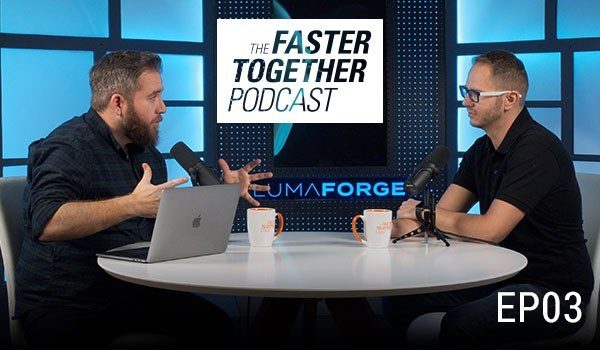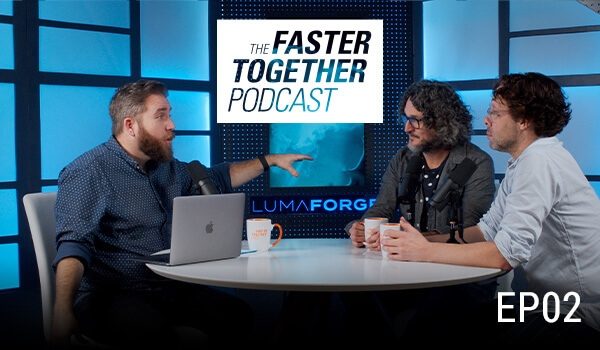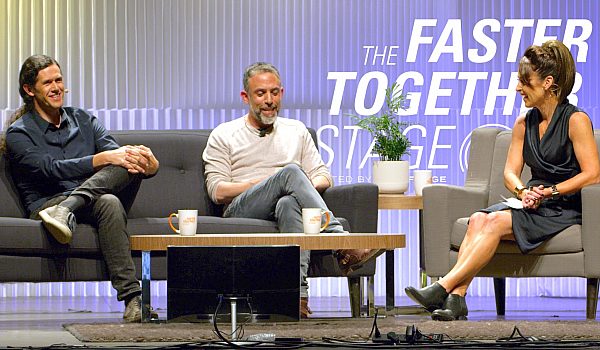Sven Pape (This Guy Edits) and Producer Dustin Hughes talk about how their independent film, "Flesh and Blood", was editing in front of 40,000 YouTube subscribers. "Flesh and Blood" recently premiered at SXSW and will be in theaters Fall 2017.
The film was the first features shot on Blackmagic Ursa Mini cameras and was edited in FCPX. It was a hybrid between narrative and documentary, using real people rather than actors.
In this presentation, Sven and Dustin talk about both the technical details of the film, as well as the creative approach used during filming and post production.
Sven Pape: Hi, good morning. Uh, thank you so much for coming. Very excited to be here. My name is Sven Pape. I'm the editor of a film called flesh and blood.
Dustin Hughes: I'm Dustin Hughes and I'm the producer and post supervisor and a bunch of other things on the film as well, like camera operating and sound mix and stuff like that for flesh and blood. And uh, I'll bring up the first sort of little bit of info. So flesh and blood is an indie feature that we shot, uh, over the course of about 23 days on location in Philadelphia, Pennsylvania. Um, this was the first feature film shot on a black magic pocket cinema 4K. it was edited and sound mixed completely in final cut 10 as well, um, for theatrical.
Sven Pape: And it is possibly the first time that a feature was actually CAD online as it was happening because the director Mark Weber was kind enough for me to allow viewers on the internet to sort of look into the world of editing, creative storytelling, all that kind of stuff. And by the time we were done, we were lucky that the film was accepted at South by Southwest just a few weeks ago. We had the Premiere there and then just last week we were able to lock in a distribution deal because of the Premiere and it's going to now be released in theaters coming in November and then streaming in January. So that's a little bit of an overview of what we're going to be talking about today. And first we wanted to just show you a trade the film, so you get an idea what it's about.
Dustin Hughes: so it's a comedy obviously and I'll hand it over to Dustin to start it off with lots of musical numbers. So I'm just going to talk, there's too much ground to cover in terms of going super in depth with technical. Um, what, what I'm going to talk about that I think is kind of important is the creative decisions that led the technical and instead of really, cause I can dig deep and pixel peep just with the best of them and I can go down that rabbit hole. But what was cool about this film was it is a very specific style that Mark, Mark Weber's the director. Um, and also the star of the film. Um, spend. This was your fourth, third time working with them. It was the second feature I worked on with him. Him and I had started experimenting with this style. He'd, he's always kind of gone towards this what we call reality cinema style.
Dustin Hughes: Um, and him and I were shooting something months before and got it in our heads that this was really cool to be very slim, um, to not have a crew of 50 standing around. Even a crew of 10 can really upset the balance on a, on a, on a set, um, because these aren't actors and this is based partially in reality. Um, and so what you're seeing is sort of a hybrid of what is real. Everybody in the film is just playing themselves and these are our bouts situations that are truthful, um, in the world. And so it's a loose sort of moving back and forth between narrative and kind of this documentary idea. So basically that really led to our decision making in our acquisitions. We needed a camera that would let us be stealthy but would give us a cinematic quality, but that wouldn't require a bunch of support.
Dustin Hughes: We needed to pull it out of the bag and be able to shoot quickly at a moment's notice. We didn't have, we didn't, couldn't have time to break down the camera, but we did have things like map boxes and Schneider optics was great. Um, we had two sets of, uh, prime lenses from them. So we were able to sort of balance this sort of cinematic quality with, you know, running gun. Um, and we use small light kits. We kept the crew small and what it was great for was being able to get these really authentic, um, performances out of people who weren't actors and let them be very natural in the world and just be themselves. So we did have a lot of different formats. Um, we shot 4.6K for a camera and then we shot production forK black magic for B cam mixed in some drone with GoPro, a little bit of pocket cinema for car shots.
Dustin Hughes: And then we had, as you saw in there, there's some Handycam stuff. So we had lots of different formats that kind of had to, they all had to gel in the post process. And we had been, we'd run tests, Fenn and I about a workflow and kind of came up with, you know, a final cut 10 workflow solution that would work. And it's also what I love about final cut 10 is that you can kinda throw anything at it. And I had adopted it early on the day it was released and I fell in love. Everybody else hated it. Most people hated it. I fell in love and went, there's something here and I put a web series through it for AOL on, um, that was like 12 episodes and I knew it could handle large stuff with multiple editors. So I wasn't too worried about that.
Dustin Hughes: Um, I think it was focused to feature that had used it. So I felt confident. Um, and then so for the workflow, we basically, um, you know, the only thing we had to worry about was making sure, cause I knew that I was doing posts and handling color grading. So one thing I knew is that we had to make sure we dealt with our frame rates. 23, nine eight is different than 24. So it was taking some of this footage and saying let's not work in proxies on this and let's just turn it into true progress masters never touch it again. That when we go into the grade, we're referencing these, there's timecode embedded, the file names are unique, we're not going to get lost in it. Um, and that really when we stayed with that, it did make the workflow really easy. When I took it back from Sven and went into the color grade and matched back the footage, um, that was really great.
Dustin Hughes: Didn't have to worry about any of that. Scaling issues, none of that. So working in 4.6K is great too because of the ability to just shift things out of the frame. If we, you know, we didn't, we didn't really do it much at all, but, um, it was really great. Um, production audio can be tricky. It's not anymore. The 10.3 I would have killed for a year ago, um, with the [inaudible] XML support. Um, but what we were using at the time sync and link, which was great, but it, it, we have a, it's somewhere here. I have this sheet that's three or four pages long with notes and pictures and a whole document I built out for this workflow to make sure that everything was done properly so that when we got into the grade, which I knew we would be doing it at the last minute, as these things always work out.
Dustin Hughes: Um, and that's what was really beautiful about final cut 10 is it let us be flexible. It let us throw things at it. It let us trade back and forth and kind of get started on the grade and break it down into reels and, and, and then final it out and then do the sound. Um, yeah, it's just a really, it was just a really great, great way to work on an indie that needed flexibility and didn't need to lock a picture, which is a whole great, fantastic thing not to have to do, um, to be sound mixing three days before your, you know, getting ready to hit your deadline for South by Southwest.
We had a really great situation because Dustin was in the field and he was operating one of the two cameras. So he had an idea what the footage is that I'm getting and he had an idea of what needs to happen at the end of the process because he then was doing the color correction at the end. So we did some tests. We figured it out. I didn't really understand a whole lot about just the compression or anything. What was really good for me was the Dustin was able to deliver me all the footage prepped in a way that he needed it to be. By the time I delivered the cut back to him, by the time I locked the cut. So we were sort of tag teaming this whole process the whole time through. And he was like checking here and I was giving you some tests every once in a while, like a test scene.
Sven Pape: So I wanted to talk a little bit more about the process, how I cut the film and why actually had a really great experience with final cut 10 in the sense that this was actually the first time that I kept a feature on 10. I've done a couple of features on avid and a couple of documentaries on final cut seven. I've never touched Premieree. So, um, I'm teaching at a film school and they have Premieree and I always have to pretend like I know what's going on, but I have yet to do a project on it. Um, so the reason why I chose to give this a try was, is because I was really in a bind on a commercial that I kept previously, which was a Christian Leverton commercial. And the footage came in in Anita to deliver a cat in I think three days.
Sven Pape: So I wasn't put in a situation where I couldn't have an assistant in jest and organize and so on and so forth. I needed to start cutting. As the footage was coming in and Dustin actually said, then you need to try find a cut 10 so I was cutting my teeth on figuring out this freaky magic, this magnetic timeline on a Christian Vuitton commercial with a deadline and just, it was so painful to understand what's going on, but once I reached that hurdle, which took probably a day and a half once I understood what they're trying to do here, that they are really trying to get away from some form of connection in this direction. It's all connected in this direction in that everything moves. If I change anything in this direction or I want to go in this way. Once I understood that I should not fight this timeline and start to embrace it, I it became very intuitive and it became a very natural experience to the point where I actually managed less.
Sven Pape: I felt like I don't have to decide where the footage, where the, the audio, the video is, is coming. Um, and I can really focus more on the storytelling. So I was like ready to try this on a feature as well. And I also wanted to talk a little bit about the process, the way that I worked with Marcus a director. Um, so this is the third time that we've worked together on features. The first time was the end of love, which was a film that went to Sundance and was also a very personal story to him. His styles always, he uses characters in his real life at the time. That was his three year old son that didn't know he wasn't a movie and he played a whole story around him being a father that is raising his child on its own, had that process and we really established some Goodwill and some trust and he really understands too.
Sven Pape: Let me do an edit test at first. So I get, I have the opportunity to pitch the story back to him and then he gets to see it. And at that point that put the sort of the positions that we have. I am the storyteller at the beginning. He's the listener switches and he tells me how he responds to the footage and I become the listener. And then we start working at the cut. And while that was going on, I suggested to him, why don't I put this whole process up on YouTube? I thought I should be beauty pie. That was my idea. Online gaming is cool. People are watching this. Why are they not watching online? Editing's just as cool. Um, not knowing that it's not about the gaming at all, but the personality. Um, so I quickly learned, Oh, I need to do more than just showing the editing.
Sven Pape: The actual process of editing is quite boring. So then I realized, Oh, I, there's an opportunity here to teach about storytelling and figuring out the creative issues that you're facing. How do you build drama? How do you create a scene in a way that it has stakes? And so that became really exciting to me and I think that's when the channel sort of gets positive response. And when blogs started to, I'm responding to it. Right now we have 52,000 subscribers and I just wanted to play this trailer to give you an idea of some of the episodes. Real quick.
Sven Pape: okay, so all different kinds of formats that I'm experimenting with on this YouTube channel. I just did a video on Werner Hertzog which is more like in a video essay style of just looking at how he as a documentary filmmaker has a very different approach than your conventional documentary filmmaker. I find it really interesting that an episode like that as well as an episode that is 25 minutes long and you just talk about drama and you take a scene from nothing from just the first shot all the way through in just by talking about, okay, well how can you move things around? How can you lose a use? Like what David Mamet said, like what does a character really want? Why right now and what happens if she doesn't get it? Like, if you take these and you infuse the scene and reshuffle everything to make sure that every scene has that dramatic arc, that an episode like this actually kind of works on the internet. So that's been the process I'm experiencing mentoring now with whole different ideas. I don't know if anybody's seen the movie the room. You should definitely check out this video. Um, that's probably the one that's gone pretty big from, I've, I did another one that when 700,000 views, I'm not going to tell her what it's about. You have to check it out.


 Mobile
Mobile
 Tower
Tower
 R24
R24
 Builder
Builder
 Manager
Manager
 Connect
Connect
 Kyno
Kyno
 Media Engine
Media Engine
 Remote Access
Remote Access
 Support
Support









